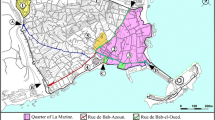Abstract
The aim of this paper is to explore the question: why is the archaeology of English historic landscapes apparently so provincial? Inevitably the response must be that matters are more complex. In this paper, I examine the work of W. G. Hoskins, the “father of English landscape history,” and draw attention to: the complex way in which landscape is embedded in nationalism; the relations between locale, province, and nation; and the way wider tensions, in particular of colonialism are embedded within Hoskins's own discourse. In conclusion, I examine ways in which this problematic continues to structure enquiry into the English landscape today and to inhibit a genuinely international and comparative approach to historic landscapes.
Similar content being viewed by others
References
Aston, M. (2002). Interpreting the Landscape From the Air, Tempus, Stroud.
Barry, J., and Brooks, C. (eds.) (1994). The Middling Sort of People: Culture, Society and Politics in England, 1550–1800, Macmillan, Basingstoke.
Bender, B., and Winer, M. (eds.) (2001). Contested Landscapes: Movement, Exile and Place, Berg, Oxford.
Beresford, M. W., and Hurst, J. G. (eds.) (1990). Wharram Percy: Deserted Medieval Village, Batsford, London.
Bermingham, A. (2000). Learning to Draw: Studies in the Cultural History of a Polite and Useful Art, Yale University Press, New Haven.
Biddick, K. (1993). Decolonizing the English past: Readings in medieval archaeology and history. Journal of British Studies 32: 1–24.
Bradley, R. (1993). Altering the Earth: The Origins of Monuments in Britain and Continental Europe, Society of Antiquaries of Scotland, Edinburgh, UK.
Bradley, R. (1998). The Significance of Monuments: On The Shaping of Human Experience in Neolithic and Bronze Age Europe, Routledge, London.
Campbell, M. (1942). The English Yeoman Under the Tudors and Early Stuarts, Yale University Press, New Haven, CT.
Clark, G. (1977). World Prehistory: In New Perspective, Cambridge University Press, Cambridge, UK.
Colley, L. (1992). Britons: Forging the Nation 1707–1837, Yale University Press, New Haven, CT.
Crawford, O. G. S. (1953). Archaeology in the Field, Phoenix House, London.
Curry, P. (1998). Defending Middle-Earth: Tolkein, Myth, and Modernity, HarperCollins, London.
Deetz, J. F. (1977). In Small Things Forgotten: An Archaeology of Early American Life, Anchor, New York.
Hill, C. (1964). Society and Puritanism in Pre-Revolutionary England, Secker and Warburg, London.
Hooke, D. (ed.) (2000). Landscape: The Richest Historical Record. SLS Supplementary Series 1, Society for Landscape Studies, Amesbury.
Hoskins, W. G. (1954). Devon, Collins, London.
Hoskins, W. G. (1955). The Making of the English Landscape, Hodder and Stoughton, London.
Hoskins, W. G. (1964). Harvest and hunger. The Listener 72: 931–932.
Hoskins, W. G. (1965). Provincial England: Essays in Social and Economic History, Macmillan, London.
Hughes, R. (1986). The Fatal Shore: A History of the Transportation of Convicts to Australia, 1787–1868, Collins, London.
Johnson, M. H. (1999). Rethinking historical archaeology. In Funari, P., Hall, M., and Jones, S. (eds.), Historical Archaeology: Back From the Edge, Routledge, London, pp. 23–36.
Johnson, M. H. (2003). Muffling inclusiveness: Some notes towards an archaeology of the British. In Lawrence, S. (ed.), Archaeologies of the British: Explorations of Identity in Great Britain and its Colonies, 1600–1945, Routledge, London, pp. 17–30.
Johnson, M. H. (in press-a). The tide reversed: An historical archaeology of Europe. In Hall, M., and Silliman, S. (eds.), Historical Archaeology, Routledge, London.
Johnson, M. H. (in press-b). Ideas of Landscape, Blackwell, Oxford.
Light, A. (1991). Forever England: Femininity, Conservatism, and Literature Between the Wars, Routledge, London.
Mandler, P. (2002). History and National Life, Profile, London.
Matless, D. (1998). Landscape and Englishness, Reaktion, London.
Meinig, D. W. (1979). Reading the landscape: An appreciation of W. G. Hoskins and J. B. Jackson. In Meinig, D. W. (ed.), The Interpretation of Ordinary Landscapes: Geographical Essays, Oxford University Press, Oxford, pp. 195–244.
Morrill, J. (1993). The Nature of the English Revolution: Essays, Longman, London.
Morton, H. V. (1927). In Search of England, Methuen, London.
Mumford, L. (1934). Technics and Civilization, Routledge, London.
Orser, C. (1996). An Historical Archaeology of the Modern World, Plenum, New York.
Philips, T. (2004). Ethnic Minorities in Rural Areas, Unpublished press release, Commission for Racial Equality, October 8.
Phythian-Adams, C. (1992). Hoskins's England: A local historian of genius and the realization of his theme. Local Historian 22(4): 170–183.
Phythian-Adams, C. (1993). Societies, Cultures, and Kinship, 1580–1850: Cultural Provinces and English Local History, Leicester University Press, Leicester, UK.
Said, E. (1978). Orientalism: Western Conceptions of the Orient, Penguin, Harmondsworth.
Said, E. (1993). Culture and Imperialism, Chatto and Windus, Harmondsworth.
Tawney, R. (1941). The rise of the gentry, 1558–1640. Economic History Review 11: 1–38.
Thirsk, J. (ed.) (2000). The English Rural Landscape, Oxford University Press, Oxford.
Thomas, J. (2004). Archaeology and Modernity, Routledge, London.
Tranter, M., Hawker, K., Rowley, J., and Thompson, M. (eds.) (1999). English Local History: The Leicester Approach, A Departmental Bibliography and History, 1948–1998, Friends of the Department of English Local History, Leicester, UK.
Williams, E. (1944). Capitalism and Slavery, University of North Carolina Press, Chapel Hill.
Author information
Authors and Affiliations
Corresponding author
Rights and permissions
About this article
Cite this article
Johnson, M.H. On the Particularism of English Landscape Archaeology. Int J Histor Archaeol 9, 111–122 (2005). https://doi.org/10.1007/s10761-005-8142-7
Issue Date:
DOI: https://doi.org/10.1007/s10761-005-8142-7




